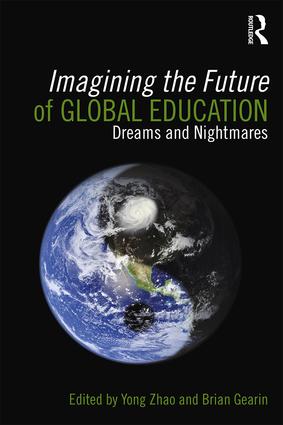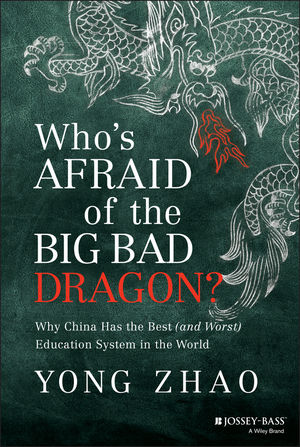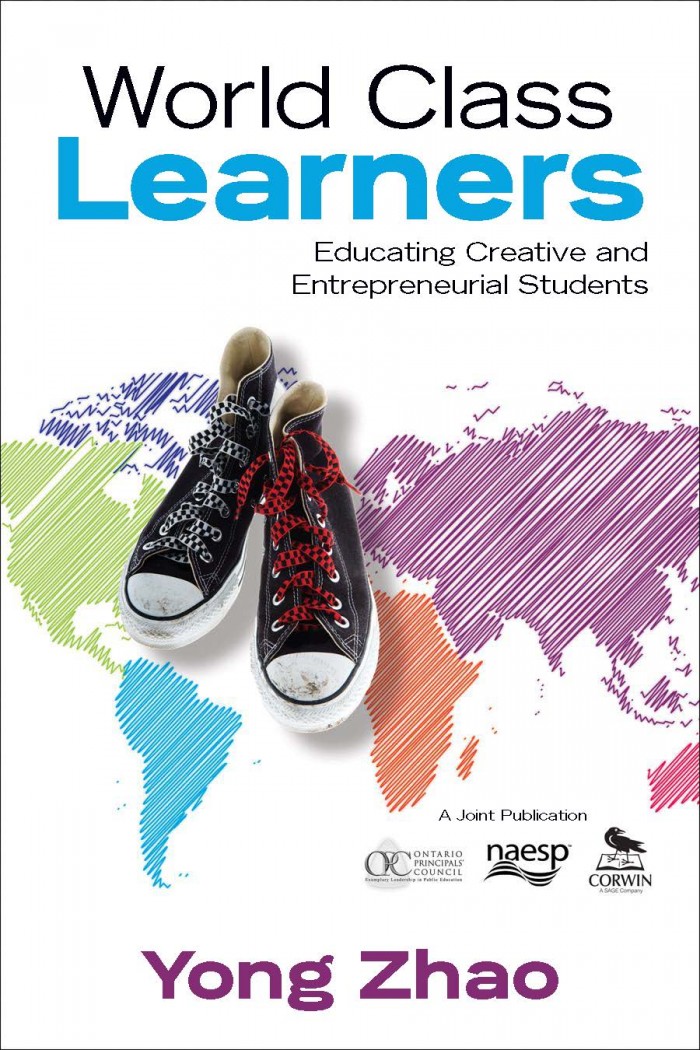China’s Determination to End School Choice and Testing: New Development
(from my new book: Who’s Afraid of the Big Bad Dragon: Why China Has the World’s Best and Worst Education to be published by Jossey-Bass)
For those who admire the Chinese education system, here is another cautionary tale. The Chinese government has (re)issued another round of orders to end two practices that have delivered China’s great test scores: school choice and testing.
In January 2014, the Chinese Ministry of Education issued a stern policy demanding all middle schools (grades 6 to 8 ) admitting students solely based on residence in an attempt to end school choice and the use of any form of exams for students advancing from primary school to middle school[1]. “Exams cannot be used by local educational administration, government schools, or private schools to select students,” stated the policy document. “Government schools cannot use any certificates of contest prizes or qualifications as basis for determining students’ eligibility for admissions.” For schools with more applicants than space, a computerized lottery is to be used.
Ending School Choice and Exams
Like everything in a centralized hieratically organized society, schools in China are organized into different tiers determined by the government. First, all schools fall into either one of the two basic categories: ordinary schools and “key” schools or “exemplary” schools. The number of key schools is limited. They are considered the best schools worthy of more government investment and special policies in many aspects, including student admissions. Second, aligned with the government hierarchy, there are different levels of key schools—national, provincial, and county/municipal/district key schools. National key schools were evaluated and bestowed by the central government. In 1995, for example, the Ministry of Education started a three-year process to evaluate and designate around 1,000 “national exemplary high schools.” Selected out of about 30,000 high schools in China, these are considered the best schools nationally. After this top tier are key schools designated by the provincial government, and then the local government.
The practice of identifying and developing key schools started in the 1950s-60s when China decided that it was necessary to concentrate its limited resources on a few schools. It was interrupted by the Cultural Revolution but quickly restored in the 1980s. Key schools receive more investment from governments and have better teachers, better facilities, and most importantly better students because they have the opportunity to select students through exams, and from a bigger pool than ordinary schools. For instance, provincial-level key schools are allowed to recruit students from an entire province while an ordinary school does not have that privilege or reputation to attract students from other places.
As a result, the quality of schools varies tremendously, by design. Practically, students in key schools have a better and much better chance to get into more prestigious universities and better employment afterwards. Hence students, parents, and schools all work hard to fight for the limited number of spots in key high schools. The primary selection criterion is test scores. Thus key schools have some of the best test-takers, who in turn further enhance the status of key schools with their excellent performance in college entrance exams. These prized schools become even more powerful financially and socially by admitting students who do not have the scores but have wealthy or powerful parents.
Competition for spots in better high schools is fierce, so is the competition for spots in prestigious middle schools because a spot in a prestigious middle school gives one a much better chance to get into a prestigious high school. For the same reason, competition for a place in prestigious elementary schools is equally, if not more, intense. The result is a national frenzy for getting better test scores all the time, starting from before the child is born.
Faced with mounting demand for equity, lessening student academic burden, and ending the “test-oriented” education, Chinese government has begun to remove the “key school” designation recently, replacing them with a new designation “exemplary schools.” The new title has no practical effect on the inequality engineered by the government in the first place. Even if the government stops designating any form of differentiation, parents still know which schools are better and will try their best to obtain a spot in them for their children.
Another approach is to stop school choice by using residence as the sole criterion for admission decisions as codified by the most recent version of the Chinese Compulsory Education Law passed in 2006. Schools, regardless of their designations, can only admit students residing in their designated district without using any form of exams or other reasons to admit students from outside their respective district.
Will It Work?
The new policy issued in January is yet another attempt to free Chinese education from the power of exams. Over the past two decades, the Chinese central government and provincial governments have issued similar policies every year. Beginning in the mid-1980s, the central government has issued multiple orders forbidding the use of exams in the admission of students to middle schools. All middle schools were required to accept students within their designated communities without using exams to determine eligibility. But in practice, these orders were generally ignored by local governments and schools until the late ’90s. Shanghai began implementing the policy in 1997; Beijing began a year later.
Officially, middle schools are no longer supposed to use formal exams to make admissions decisions and must enroll students residing in their communities. Nor are schools supposed to enroll students from outside their communities (a common way to recruit more academically talented students or increase financial resources by charging a fee to those less talented). In reality, both practices continued, forcing central and local governments into an annual exercise of issuing more orders and policies. In 2000, for instance, the Ministry of Education issued an order prohibiting the use of any form of written exams to select students. In 2005, the Ministry of Education ordered all government schools to offer classes in Math Olympiad and reference qualifications in Math Olympiad for admissions. In 2006, the Chinese legislature passed the revised Compulsory Education Law, which made using exams to admit students to middle school illegal. In 2009, a similar order was issued again, demanding that schools not give any form of exams and associating admissions with students winning prizes in subject contests. In 2013, the Ministry of Education issued similar orders once more—and again in 2014.
The fact that such orders continue to be issued shows what little effect their predecessors have had. To show compliance, schools and local governments may have stopped formal and open exams, but they have invented new forms of exams or conducted exams without calling them entrance exams. In 2010, a group of middle schools in Sichuan were reported for holding a “scholarship exam,” which was to be used for admissions decisions[2]. In 2009, a middle school in Shanxi Province used a commercial tutoring service to conduct its admissions exam. Children who wished to attend the school had to pay for tutoring and the opportunity to take the exams. The training provider could recommend students to the school, and of course, the school happened to only admit students recommended by the provider. This type of joint venture has become a popular way for schools to identify the best students and enhance revenue, all while evading government scrutiny. A joint venture might offer out-of-school tutoring in the Math Olympiad, English, and other special “talents.” These tutoring programs also serve as a selecting mechanism for the middle schools. Additionally, while schools are banned from using written exams, they can still conduct interviews—which have become another form of testing[3].
A 2013 study conducted by the 21st Century Education Research Institute, a Chinese non-profit think tank, found 15 different ways for students to advance from primary to middle school in Beijing. Officially, there should be only one way: residency in the district. “Invisible and alternative forms of exams have defeated the advancing without exams,” the study concludes[4].
“Thus, more than a decade of history of prohibition orders from educational departments has been a history of ineffective orders,” notes a report[5] in China Weekly after reviewing numerous attempts to curtail the power of testing in Chinese education.
New Competition
If this new round of policies were to be more effective, China would face another round of competition that may result in greater inequality: parents with the wealth would buy residence; parents with the social capital would work to change their residence registrations. Both have already happened in areas that have been experimenting with the practice of no-school-choice. One consequence is that students from poor families who could have the opportunity to get into a good school with test scores would then be denied the opportunity because they do not live in the right neighborhood. A problem America is familiar with.
[1]http://news.xinhuanet.com/edu/2014-01/26/c_119141269.htm
[2] http://news.163.com/10/0423/04/64U6H31C00014AED.html
[3] http://www.21cedu.org/index.php?m=content&c=index&a=show&catid=124&id=3320&page=4
[4] http://news.xinhuanet.com/edu/2013-12/11/c_125838505.htm
[5] http://www.chinaweekly.cn/bencandy.php?fid=63&id=6847




























[…] YongZhao (from my new book: Who’s Afraid of the Big Bad Dragon: Why China Has the World’s Best […]
Very interesting! I read today in the news that the most recent PISA assessments revealed that in math children of janitors in Shanghai score better on average than children of wealthy professionals in Canada. On the other hand, where Canada does perform relatively well is in ensuring fairly equitable outcomes. While scores from Shanghai are unlikely to be generalizable to the rest of China, it does seem that at least in more economically developed regions China’s education system is clearly capable of delivering.
My question is, how stark are the inequities in places like Shanghai and Beijing? And are they really such a problem if outcomes at the bottom end of the distribution are so robust when considered in global comparative context?
And I suppose a third question would be, are China’s education reforms focused in the cities, or is more attention being paid to reducing urban-rural disparities?
Thanks!
Hi, Gareth,
Thanks. I am working on a number of follow-up posts about these issues and also my book contains a lot more information. But the short and quick answer is: the inequalities are huge and the reforms are trying to address both within cities as well as reducing urban-rural disparities.
[…] via Education in the Age of Globalization » Blog Archive » China’s Determination to End School Choic…. […]
[…] [Web log post]. Retrieved from http://zhaolearning.com/2014/02/19/china%e2%80%99s-determination-to-end-school-choice-and-testing-ne… Please share this post:Share on TumblrPrintEmailLike this:Like […]
This could be an issue “primary school advancing to middle school” considering the capability of a primary student advancing to more complex studies would they be able to cope up to the required skills.
Feel free to comment:
The views expressed on this site are entirely my own. They do not represent my employer or any other organization/institution. All comments are subject to approval.Archive
03.17.24 Focused: Understanding, Negotiating, and Maximizing Your Influence as a School Leader
02.25.24 What Happened to Global Competence?
08.05.23 Rethinking the time spent at school: Could flexibility improve engagement and performance for students and teachers?
01.17.23 Introduction to Improbable Probabilities: The Unlikely Journey of Yong Zhao
01.05.23 How Not to Kill Creativity?
08.19.22 Preface to Improbable Probabilities: The Unlikely Journey of Yong Zhao
02.05.22 Introduction to New Book: Learning for Uncertainty: Teaching Students How to Thrive in a Rapidly Evolving World
09.25.21 Side effects in education: Taxonomy of educational outcomes
07.13.21 Introduction to My New Book: Learners without Borders
03.09.21 New article: Build back better: Avoid the learning loss trap
02.18.21 New article: The changes we need: Education post COVID-19
09.15.20 Watch Ep4 Creativity in Crisis: How well is creativity understood? A Conversation with Barb Kerr, Haiying Long, Ron Beghetto, & Yong Zhao
08.15.20 Can Creativity be Taught? Ep 3 of Creativity in Crisis on August 28th 3:00-4:00pm Pacific Time
07.13.20 Speak a Different Language: Reimagine the Grammar of Schooling
06.11.20 Assessing Creativity in the Classroom? Recording of Ep2 of Creativity in Crisis
Tag Cloud
Accountability achievement gap CCSSO China/Chinese Commissioner Common Core Standards education Educational Policy Education Reforms national standards New York NGA Singapore standardized testing Standards student performance
WP Cumulus Flash tag cloud by Roy Tanck and Luke Morton requires Flash Player 9 or better.
Silverliningforlearning
Most Commented
Most Viewed
Views expressed on this site are entirely personal. They do not necessarily represent the official positions or views of my employer
Powered by WordPress | Log in | Entries (RSS) | Comments (RSS) | Arthemia theme by Michael Hutagalung